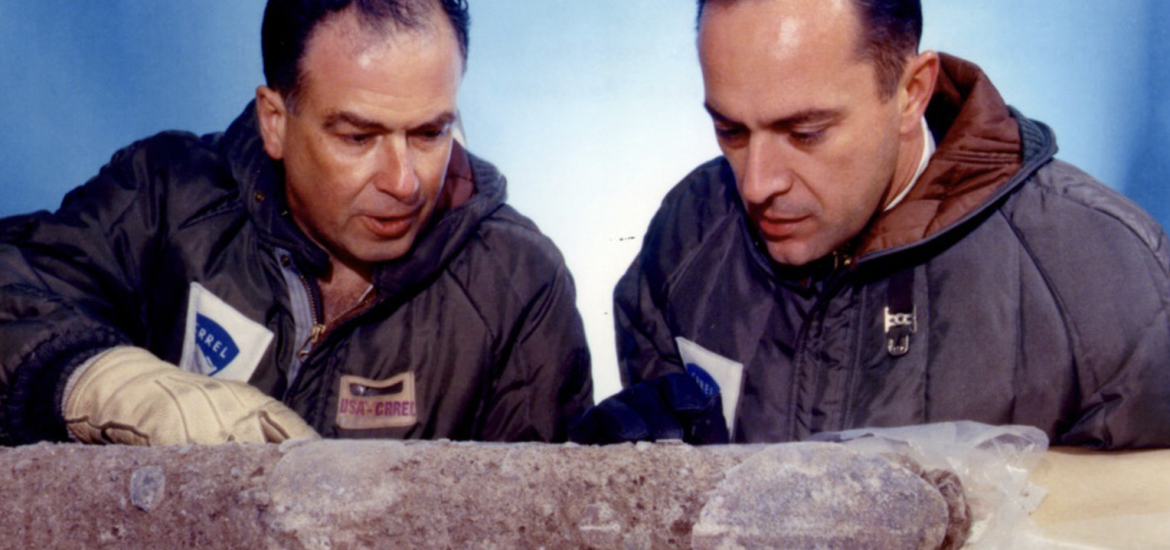- Home
- All News Overview
- Featured Article: Horizons Magazine (2) - From a Secret Cold War Project To The Future of The Ice Sheet

Tuesday, 3 January, 2023
Story and interview by Andrew Christ and Paul Bierman
---
The deadline for Horizons contributions: volume 3 is on 31 January 2023. If you are interested in finding out more about getting involved in Past Global Changes Horizons - a popular science magazine aimed primarily at the younger generation, budding scientists, and all those enthusiasts both young and old who are interested in, or want to learn more about, the science of the past - you can find all details here.
---
From a secret cold war project to the future of the ice sheet
You’re about to embark on a journey to Camp Century, a nuclear-powered U.S. Army base built in 1959 and 1960. It was a grid of thousands of feet of snow tunnels dug into the Greenland Ice Sheet*. You might feel like you’re watching an old James Bond movie or even entering a science fiction novel, right?! Yet, the science born out of this military adventure is anything but fiction. Recently, alarming secrets about the potential future of the Greenland Ice Sheet have come to light from sediment at the bottom of an ice core collected beneath the base.
During the Cold War in the 1950s, the threat of Soviet attack over the Arctic Ocean led to a military build-up in the far north by the U.S. and its NATO allies. In northwestern Greenland, the Danish government allowed the U.S. to construct Thule Air Base in 1951. The airbase hosted sensitive radar and a runway long enough for strategic bombers; Thule could house up to 10,000 people.
With Thule as a base, the U.S. military began to explore the arctic using motorized convoys and airsupported expeditions. In 1953, they built the first camps in the ice, known as Sites I and II; these were radar installations disguised as weather stations. The bases were metal tubes under the snow filled with insulated barracks and they worked – 18 soldiers lived at 25°C (77°F) while the winds howled above them.
A few years later, the Army began hauling men, construction materials, and machines across the ice sheet to build a different type of base. They went big and used native materials, snow, and ice for construction. First came Camp Fistclench, nearly 300 km (200 mi) from the edge of the ice sheet. Trenches were dug out of the snow by Swiss Peter Plows that once cleared deep snow from passes in the Alps. Then, the trenches were roofed with wood and metal arches and snow blown on top – it quickly sintered to form a hard, camouflaged roof.
The proof of concept worked, and soon the same engineers designed Camp Century, named after the planned distance along the ice road, 100 miles (160 km). But nature didn’t cooperate, and the right site, one flat enough to build the camp in the dry snow zone, was actually 138 miles (222 km) from the edge of the ice sheet. Men, materials, and fuel moved to Camp Century across the ice in heavy swings, tractors pulling sleds including heated living quarters and mess halls. The swings moved at about the speed people could walk, and took three days to reach Camp Century from Thule.
Between 1961 and 1963, Camp Century was powered by a small nuclear reactor and housed over 100 soldiers, scientists, and engineers, all of whom lived in heated, insulated, prefabricated buildings within the tunnels cut into the snow (Fig. 7). Camp Century was a chilly place to walk around since the interior temperature was kept well below freezing, which was necessary to keep the snow tunnels intact!
Camp Century was highly visible to the public and used as a Cold War propaganda tool in the U.S. The army welcomed coverage from media outlets including National Geographic, Popular Science, and international newspapers (Fig. 8). To optimize military operations in the challenging and harsh Arctic environment, the U.S. Army needed scientists to study the ice and snow itself. It's also possible that the U.S. had a more insidious motive: a secret mission called Project Ice Worm that sought to hide nuclear weapons and move them by rail inside the Greenland Ice Sheet — away from prying Soviet eyes. However, this project was never fully realized — not even close, although a short section of railway was built in one of Campy Century’s tunnels.
In the meantime, snow and ice scientists went to Camp Century. Their purpose was to study the properties of ice and snow, drill into the ice sheet, and learn more about Earth’s climate history preserved in the ice and snow.
Swiss scientist Henri Bader convinced the U.S. military they needed to understand the fundamental properties of snow and ice in order to operate at the poles. Bader had other motives as well: by 1950 he suspected that ice cores drilled in glaciers and ice sheets would recover the annual layers of snowfall that would preserve important records of climate and atmospheric composition.
Chester Langway, a young American scientist, was brought by Bader to Greenland in 1956 and began collecting shallow ice cores (a few hundred meters, or up to 1000 ft) from other military outposts on the ice sheet and developing methods for measuring important variables on the ice samples.
> Continue reading ...
---
> Access Horizons volume 2 (2022)
> Access Horizons volume 1 (2021)